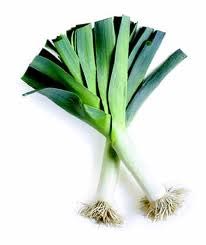LEEKS: Reasons to Eat Them, Secrets to Prepping Them, & Tips on Using Them
By Alice Osborne
 Leeks, like garlic and onions, belong to a vegetable family called the Allium vegetables. And like garlic and onions, they contain many of the same beneficial compounds found in these well-researched, health-promoting vegetables.
Leeks, like garlic and onions, belong to a vegetable family called the Allium vegetables. And like garlic and onions, they contain many of the same beneficial compounds found in these well-researched, health-promoting vegetables.
With their unique combination of flavonoids and sulfur-containing nutrients, the allium vegetables belong in your diet on a regular basis. There's researched evidence that promotes including at least one serving of an allium vegetable in your meal plan every day. If you're choosing leeks, make your individual portion 1/2 cup or greater, and try to include at least one cup of chopped leeks in your recipes.
While low in calories, they are high in vitamins K, A, C, B6, folate, manganese, iron, magnesium, molybdenum, copper, calcium, potassium, and fiber.
 Leeks look like large scallions, having a very small bulb and a long white cylindrical stalk of superimposed layers that flows into green, tightly wrapped, flat leaves. Garden grown leeks are about 12 inches in length and one to two inches in diameter and feature a fragrant flavor that is reminiscent of shallots but sweeter and more subtle. Wild leeks, known as ramps, are much smaller in size and have a stronger, more intense flavor.
Leeks look like large scallions, having a very small bulb and a long white cylindrical stalk of superimposed layers that flows into green, tightly wrapped, flat leaves. Garden grown leeks are about 12 inches in length and one to two inches in diameter and feature a fragrant flavor that is reminiscent of shallots but sweeter and more subtle. Wild leeks, known as ramps, are much smaller in size and have a stronger, more intense flavor.
Although leeks are available throughout the year they are in season from the fall through the early part of spring when they are at their best.
 Many people are unfamiliar with how to cook leeks or how to include them into their eating plan. Professional chefs and nutritionists recommend cutting them very thinly and sauteing them. Like their allium cousins, onions and garlic, leeks should sit for at least 5 minutes after cutting and before cooking, to enhance their health-promoting qualities.
Many people are unfamiliar with how to cook leeks or how to include them into their eating plan. Professional chefs and nutritionists recommend cutting them very thinly and sauteing them. Like their allium cousins, onions and garlic, leeks should sit for at least 5 minutes after cutting and before cooking, to enhance their health-promoting qualities.
Here are a few preparation tips I found on WholeFoods.com:
 1) Cut off green tops of leeks and remove outer tough leaves.
1) Cut off green tops of leeks and remove outer tough leaves.
2) Cut off root and cut leeks in half lengthwise.
3) Fan out the leeks and rinse well under running water, leaving them intact.
4) Cut leeks into 2-inch lengths.
5) Holding the leek sections cut side up, cut lengthwise so that you end up with thin strips, known as the chiffonade cut, slicing until you reach the green portion. Very thin slices will shorten cooking time.
6) Important and worth repeating: Let leeks sit for at least 5 minutes before cooking.
 Wholefoods.com also had suggestions on the healthiest way to cook leeks:
Wholefoods.com also had suggestions on the healthiest way to cook leeks:
1) Heat 3 tablespoons of broth in 10-12 inch stainless steel skillet until it begins to steam.
2) Add 1 pound of cut and well-washed leeks.
3) Cover and saute for 4 minutes.
4) Add 2 more tablespoons of broth, reduce heat to medium low, and saute for 3 more minutes uncovered while stirring frequently.
5) Toss with 2 tablespoons of extra virgin olive oil, 1 teaspoon of lemon juice and salt and pepper to taste.
And finally, here are a few WholeFood.com quick serving ideas
 Saute leeks and fennel together then garnish with fresh lemon juice and thyme.
Saute leeks and fennel together then garnish with fresh lemon juice and thyme.
 Add fresh, finely chopped leeks to salads.
Add fresh, finely chopped leeks to salads.
 Make vichyssoise, a cold soup made from pureed cooked leeks and potatoes.
Make vichyssoise, a cold soup made from pureed cooked leeks and potatoes.
 Add leeks to broth and stews for extra flavoring.
Add leeks to broth and stews for extra flavoring.
 Use braised leeks, sprinkled with fennel or mustard seeds, as a tasty and unique side dish for fish, poultry or steak.
Use braised leeks, sprinkled with fennel or mustard seeds, as a tasty and unique side dish for fish, poultry or steak.
 Add sliced leeks to your favorite omelet or frittata recipe.
Add sliced leeks to your favorite omelet or frittata recipe.
With a more delicate and sweeter flavor than onions, leeks add a subtle touch to recipes without overpowering the other flavors that are present. Once you discover this unique vegetable, it could easily become one of your basic cooking ingredients.

